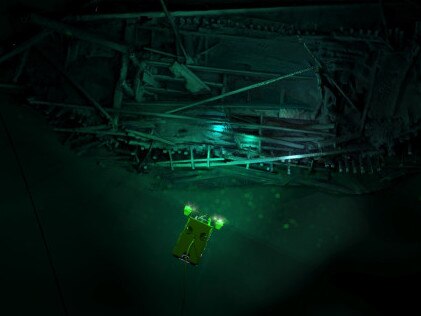Ghostly ship graveyard in Black Sea reveals clues in mystery of Noah’s Ark
A ghostly underwater graveyard containing 60 ancient shipwrecks may hold the key to cracking one of the most famous Bible mysteries.

Science
Don't miss out on the headlines from Science. Followed categories will be added to My News.
A mysterious deep sea graveyard containing scores of ancient shipwrecks could help solve one of the Bible’s most famous mysteries, scientists say.
The site, discovered in the Black Sea off the coast of Nessebar, Bulgaria in 2016 by oceanographers mapping the sea floor, may reveal the historical origin of the Noah’s Ark legend.
The eerie spot 300m below the surface — in an area known as the “dead zone” — is the final resting place of an estimated 60 ancient Greek vessels dating as far back as 400BC.
A lack of oxygen at such depths means the wrecks are perfectly preserved, their timber virtually decay free, leaving structures and even intricate carvings intact.


Some of the vessels are in such good condition even individual chisel marks on the planks of hulls are visible to the naked eye.
According to the BBC, the ships are revealing answers about the mysterious tale of Noah’s Ark in the Bible.
RELATED: Truth about ‘treasure’ chest at centre of MH370 search boat rumours
Some scholars believe the apocalyptic flood, which the Bible says was sent by God to wipe out corruption and violence in the world, originated in the Black Sea 7600 years ago.
The legend was originally told in the Babylonian creation myth Enuma Elish and in the Mesopotamian Epic of Gilgamesh before becoming universally known as the biblical story of Noah’s Ark.


In the 2000 bestseller Noah’s Flood by William Ryan and Walter Pitman, marine biologists theorise that about 20,000 years ago, what is now known the Black Sea was a small freshwater lake cut off from the Mediterranean by a giant land bridge.
According to the Noah’s flood theory — which is not backed by scientific evidence — the bridge began to decay at the end of the last Ice Age.
Melting polar ice caps caused the waters of the Mediterranean to rise, triggering a massive seawater deluge 200 times more powerful than Niagara Falls.
It caused the Black Sea to explode in size and, flooding at a rate of more than 1km per day, swallow up an area of land “the size of Ireland”.


In 2000, scientists found what is believed to be the Black Sea’s pre-flood shoreline after unearthing buildings erected by the ancient civilisations 20km from the Turkish coast.
Now scientists from the Black Sea Maritime Archaeology Project (MAP) hope underwater soil samples taken near the Nessebar shipwrecks will help prove or disprove the Noah’s Flood theory.
They hope to uncover whether waters really did flood into the Black Sea at a catastrophic pace thousands of years ago, as described in the Bible.
“The geophysicists and other specialists from the oceanographic centre in Southampton, say there’s no evidence to support this theory,” MAP Dr Zdravka Georgieva told The Sun.
“What we collected doesn’t prove this catastrophic flood. Data shows a more likely gradual sea level rising.”
Originally published as Ghostly ship graveyard in Black Sea reveals clues in mystery of Noah’s Ark



